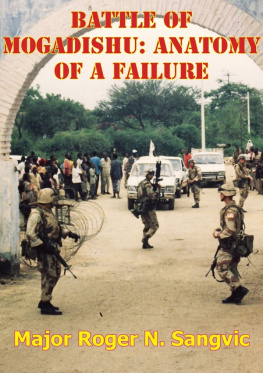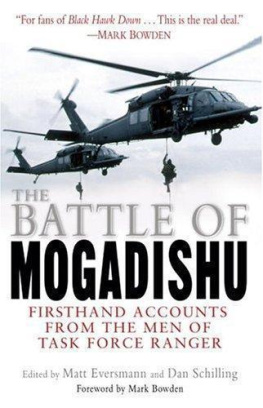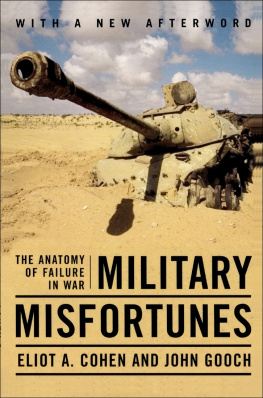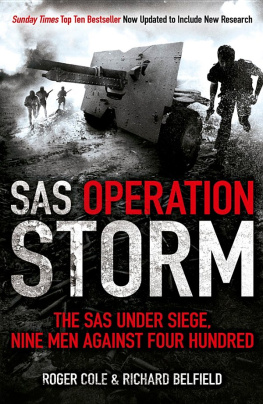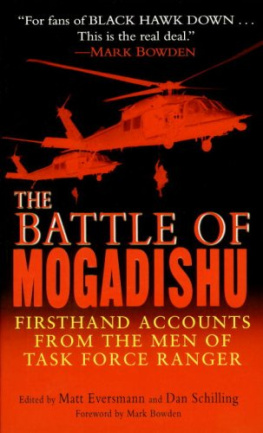Major Roger N. Sangvic - Battle Of Mogadishu: Anatomy Of A Failure
Here you can read online Major Roger N. Sangvic - Battle Of Mogadishu: Anatomy Of A Failure full text of the book (entire story) in english for free. Download pdf and epub, get meaning, cover and reviews about this ebook. year: 2017, publisher: Pickle Partners Publishing, genre: Art. Description of the work, (preface) as well as reviews are available. Best literature library LitArk.com created for fans of good reading and offers a wide selection of genres:
Romance novel
Science fiction
Adventure
Detective
Science
History
Home and family
Prose
Art
Politics
Computer
Non-fiction
Religion
Business
Children
Humor
Choose a favorite category and find really read worthwhile books. Enjoy immersion in the world of imagination, feel the emotions of the characters or learn something new for yourself, make an fascinating discovery.
- Book:Battle Of Mogadishu: Anatomy Of A Failure
- Author:
- Publisher:Pickle Partners Publishing
- Genre:
- Year:2017
- Rating:4 / 5
- Favourites:Add to favourites
- Your mark:
- 80
- 1
- 2
- 3
- 4
- 5
Battle Of Mogadishu: Anatomy Of A Failure: summary, description and annotation
We offer to read an annotation, description, summary or preface (depends on what the author of the book "Battle Of Mogadishu: Anatomy Of A Failure" wrote himself). If you haven't found the necessary information about the book — write in the comments, we will try to find it.
Battle Of Mogadishu: Anatomy Of A Failure — read online for free the complete book (whole text) full work
Below is the text of the book, divided by pages. System saving the place of the last page read, allows you to conveniently read the book "Battle Of Mogadishu: Anatomy Of A Failure" online for free, without having to search again every time where you left off. Put a bookmark, and you can go to the page where you finished reading at any time.
Font size:
Interval:
Bookmark:

This edition is published by PICKLE PARTNERS PUBLISHINGwww.picklepartnerspublishing.com
To join our mailing list for new titles or for issues with our books picklepublishing@gmail.com
Or on Facebook
Text originally published in 1998 under the same title.
Pickle Partners Publishing 2014, all rights reserved. No part of this publication may be reproduced, stored in a retrieval system or transmitted by any means, electrical, mechanical or otherwise without the written permission of the copyright holder.
Publishers Note
Although in most cases we have retained the Authors original spelling and grammar to authentically reproduce the work of the Author and the original intent of such material, some additional notes and clarifications have been added for the modern readers benefit.
We have also made every effort to include all maps and illustrations of the original edition the limitations of formatting do not allow of including larger maps, we will upload as many of these maps as possible.
BATTLE OF MOGADISHU: ANATOMY OF A FAILURE
By
MAJ Roger N. Sangvic, USA
By applying Cohen and Goochs model to the Battle of Mogadishu, this paper shows that the failure of the TFR mission on 3-4 October 1993 was the result of a system failure. Secretary Aspin received far more blame than he deserved for making the decision. Misperception of the real impact tanks and APCs could have had on the overall mission is the real cause of this disproportionate blame. GEN Hoar and GEN Powell, in addition, bear as much responsibility as Secretary Aspin for the decision. Neither of these generals strongly advocated the deployment to Aspin even though the worsening situation on the ground merited their strong support. Both Hoar and Powells approval recommendations can be characterized as lukewarm. Aspins real failure was of not being more critical of the conduct of the TFR operations. In light of Secretary Aspins acknowledged concern over the number of similar operations conducted by TFR and his knowledge that the Administration was seeking a political solution, he should have notified MG Garrison of the policy shift though the JCS and CINCCENT and provided additional guidance on risk. Had Aspin either reassessed the risk of each TFR operation more thoroughly or done a better job coordinating the policy shift in light of the increased risks, it is likely that the three October raid would not have occurred.
While better policy coordination from the Secretary of Defense down to TFR could have prevented the 3 October 1993 raid from occurring, TFR did have all the means in Mogadishu to successfully accomplish the mission. However, overconfidence in TFRs capabilities and underestimation of the enemys ability to find and attack TFR vulnerabilities were critical failures that led to a series of other failures. First, TFR did not request the AC-130s and extra platoon. Second, TFR conducted the 3 October raid without protecting its vulnerable helicopters. Third, TF planners failed to utilize all their available resources and integrate these resources into a plan that could be flexible enough to handle the threat and all the friction in this risky operation.
This paper demonstrates that TF Rangers 3 October mission failed as a result of the organization, not the decisions of Secretary Aspin alone. As Cohen and Gooch observed, military misfortune is not merely the result of an individual mistake, but rather, the result of series of mistakes throughout a system. Ultimately, TFR and the system it was working in failed to anticipate and adapt.
Failure is something that most organizations have great difficulty dealing with. The military, as an organization, has an especially difficult challenge in dealing with failure because military failures normally result in more than lost debates, dollars, resources, or market shares. Military misfortunes result in lives being lost, soldiers being crippled and maimed, future nature of military failures is essential for the U.S. military to learn its hard gained lessons and develop systems to prevent the reoccurrence of similar failures. A detailed critical analysis of military failures like the Battle of Mogadishu is required to avoid emotionalism and the natural tendency to seek a simple cause for the failure.
Clausewitz advocated detailed critical analysis of
This of war.
This type of critical analysis is necessary because too much emphasis has been placed on then Secretary of Defense Les Aspins role in the failure of the Task Force Ranger mission to capture Aideed and not enough effort has been placed on critically analyzing how all of the tactical, operational, and strategic decisions and actions led to the failure. Since it was widely perceived that Secretary Aspin lost his job as a result of his failure to approve tanks and APCs for Somalia in September 1993, many people infer that the tanks and APCs would have significantly changed the outcome of the battle and thus the success of UNOSOM II. That may not be the case. According to Cohen and Gooch, military misfortune occurs as a result of failures in systems and organizations, not simply because of one individual. By using Cohen and Goochs method of analysis, this paper seeks to discover whether Les Aspins disapproval was the critical lapse that led to the failed mission or whether there were a number of critical lapses in the system and organization that worked in concert to result in failure. To conduct this analysis, this paper discusses some of the key decisions made at the tactical, operational, and strategic levels that ultimately influenced what happened on the ground during those two days in October 1993. Through Cohen and Goochs systematic analysis, this monograph determines what all the critical lapses/tasks were and if Secretary Aspins decision not to approve additional tanks and APCs was one of them.
Cohen and Goochs methodology provides a comprehensive method of analyzing military misfortunes. Underlining their methodology is their belief that military organizations are complex, adaptive organizations. As such, misfortunes are the result of systemic and organizational failures that can be categorized in three ways: failure to learn, failure to anticipate, and failure to adapt.
In order to determine the roots of these failures, Cohen and Gooch advocate that military misfortunes be evaluated holistically; i.e., a Clausewitzian Kritik. According to Cohen and Gooch, the Clausewitzian Kritik has three steps: the discovery of facts, the tracing of efforts to causes, and the investigation and evaluation of means.
This paper uses this methodology to analyze the failure of the Battle of Mogadishu. The first step in the methodology is the discovery of the facts, determining what exactly happened. was the result of a failure to anticipate, to learn, to adapt, a combination of two these failures (an aggregate failure), or a combination of all three (a catastrophic failure). After revealing the nature of the U.S. failure in the Battle of Mogadishu, this paper concludes with some lessons that can be learned from analyzing the U.S. failure in the Battle of Mogadishu.
The Discovery of facts must include a brief history of why Task Force Ranger was called to Somalia and what happened on 3-4 October. The pre-deployment history provides a context for what happened during the actual raid. It describes some of the policy decisions that inadvertently led to the TFR deployment. It recounts the U.N.s unsuccessful attempts to capture Aideed, the use of AC-130s and their withdrawal, the escalation of violence by both sides, and the NCAs decision to send TFR. The detailed description of the actual battle is necessary to understand the timing of events as they relate to the ability of additional tanks and APCs to have prevented failure of the mission. The battle narrative also serves the purpose of illuminating various critical failures.
Next pageFont size:
Interval:
Bookmark:
Similar books «Battle Of Mogadishu: Anatomy Of A Failure»
Look at similar books to Battle Of Mogadishu: Anatomy Of A Failure. We have selected literature similar in name and meaning in the hope of providing readers with more options to find new, interesting, not yet read works.
Discussion, reviews of the book Battle Of Mogadishu: Anatomy Of A Failure and just readers' own opinions. Leave your comments, write what you think about the work, its meaning or the main characters. Specify what exactly you liked and what you didn't like, and why you think so.

